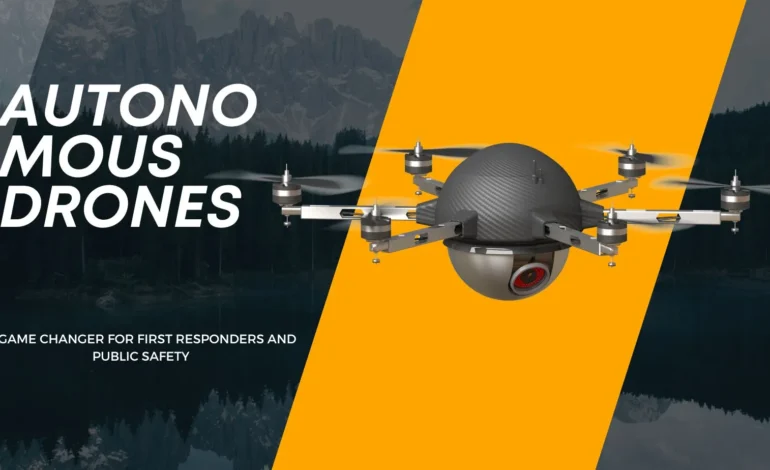
Autonomous Drones: A Game Changer for First Responders and Public Safety
Imagine a fire raging through a forest, spreading fast. The heat is unbearable. It’s difficult for first responders to assess the situation. But then, a drone zips overhead, capturing every detail. Within seconds, firefighters know where the flames are headed. They can make better decisions, faster. That’s the future of public safety.
Drones for first responders are changing everything. From chasing down criminals to finding lost hikers, these smart flying machines are becoming the ultimate tool for first responders. They’re fast, efficient, and fearless. Most importantly, they’re saving lives. These drones aren’t just fancy tech toys. They’re essential. This article will tell you how these incredible machines work and how they’re transforming the way public safety teams do their job.
Table of Contents
Enhancing Real-Time Situational Awareness
Speed matters in emergencies. But what if you could see the entire situation unfold from above? Drones do that. They give a bird’s-eye view of dangerous areas. Whether it’s a fire, a flood, or a crime scene, they show responders exactly what’s happening in real-time.
Responders no longer have to guess. Instead, they can see. Autonomous drones are equipped with cameras that send live video back to command centers. This helps police, firefighters, and paramedics act with precision. They know where to go, who to help, and what tools they need. The result? Fewer mistakes, more lives saved.
Faster Response Times
Minutes matter during emergencies. Sending in a human crew can take time. Drones, however, can be deployed in seconds. And they can travel quickly. They get to the scene faster than any team on foot or in vehicles.
For example, imagine a car crash on a busy highway. The longer first responders take to get there, the greater the risk. With drones, teams can assess the damage, find injured people, and get the right help there quickly. The speed of drones turns minutes into seconds, which can be the difference between life and death.
Improved Decision-Making with Aerial Intelligence
Better decisions come from better information. These devices provide that information. They fly into places people can’t reach. High in the air or deep into dangerous zones. Their sensors and cameras pick up details that would take humans hours to find.
These flying assistants help teams make tactical choices. They can spot the source of a fire, track a suspect, or scan an entire disaster area in moments. By using drones, first responders don’t just guess. They know. They see everything from the sky and use that data to act swiftly and effectively.
Keeping First Responders Safe
Public safety work is risky. Fires, floods, and criminal activities put responders in harm’s way. Autonomous drones can step in where it’s too dangerous for humans. They scout ahead. They search for threats. And they keep teams safe from unnecessary risks.
For example, in a fire, drones can detect hot spots. Responders can avoid entering unsafe areas. In a crime situation, drones can monitor a suspect without putting officers in direct danger. They act like shields, protecting the people on the ground.
Day and Night Missions
Emergencies don’t wait for daylight. Thankfully, drones don’t need daylight to operate. With thermal imaging cameras, they can see in the dark. They can fly at night and still capture detailed images.
Search and rescue operations, for instance, often happen after sunset. When someone is lost, time is of the essence. With drones, the search continues even in the darkest hours. They can find body heat, track movements, and locate missing persons faster than any human search team ever could.
Search and Rescue: Every Second Counts
Imagine a child lost in the woods. The clock is ticking. Every minute matters. Drones can cover large areas quickly, scanning for movement or body heat. Their ability to search vast terrains at high speeds makes them perfect for rescue operations.
They don’t get tired. They don’t stop. They work 24/7 to save lives. Rescue teams can now locate missing persons in a fraction of the time it once took. The result? More lives saved, fewer tragedies.
How to Start a Drone as a First Responder Program
Starting a drone program is easier than you think. First, assess your needs. Do you need drones for search and rescue, surveillance, or firefighting? Next, ensure you follow local regulations, get the right certifications, and train your team.
Many companies specialize in drones and can offer support. They provide the drones, training, and tools needed to get your program off the ground. The right partner makes all the difference. Choose a company that knows how to work with first responders. They’ll guide you every step of the way.
Drones for first responders are reshaping public safety. They save lives, reduce risks, and make teams more efficient. The future is already here. Public safety teams need to adapt and embrace this powerful technology. Drones aren’t just helpful—they’re essential. With the right tools and partners, your team can take to the skies.





